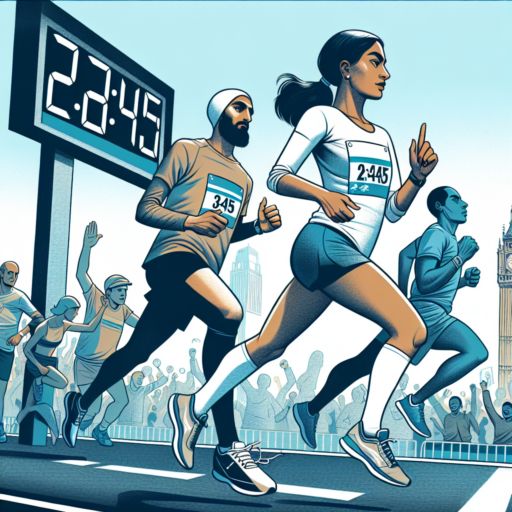What is the 2:45 Marathon Pace?
Understanding the specifics of the 2:45 marathon pace is essential for runners targeting this impressive time goal. To break it down, a 2:45 marathon requires maintaining a steady pace throughout the 26.2-mile (42.2 kilometers) distance. Achieving this time is a notable milestone in the marathon community, often signifying the transition from amateur to elite status among long-distance runners.
At its core, the 2:45 marathon pace is about consistency and endurance. Specifically, runners need to sustain an average speed of approximately 6 minutes and 17 seconds per mile, or 3 minutes and 54 seconds per kilometer. This pace demands not only physical readiness but also a strategic approach to pacing and energy distribution across the different segments of the marathon.
Preparing for a marathon with a target time of 2:45 encompasses a detailed training plan that focuses on both speed and distance. Runners often incorporate interval training, tempo runs, and long-distance runs into their regimen. The goal is to enhance aerobic capacity, improve running economy, and increase the threshold at which lactic acid builds up, which are critical factors in sustaining the 2:45 marathon pace.
How to Train for a 2:45 Marathon?
Training for a marathon that you aim to complete in under 2 hours and 45 minutes requires a specific and disciplined approach to running and fitness. The key is to balance intensity with recovery, ensuring you build both speed and endurance without overtraining or injuring yourself. Here’s a closer look at how to structure your marathon training effectively.
Focus on Consistent Mileage
Building a solid base of consistent mileage is crucial. Gradually increase your weekly running volume, ensuring that you include one long run each week. This long run should progressively lengthen to at least 20-22 miles (32-35km) to simulate the marathon distance. However, be cautious not to ramp up your mileage too quickly; a good rule of thumb is to increase your weekly distance by no more than 10%.
Incorporate Speed Work and Tempo Runs
To achieve a marathon finish time of 2:45, you’ll need to maintain a pace of approximately 6:17 per mile (or 3:54 per km). Incorporating speed work into your training can help develop the necessary leg speed, while tempo runs will improve your lactate threshold, allowing you to sustain a faster pace for longer. Ideal speed workouts might include 1km repeats at a slightly faster pace than your goal marathon pace, with adequate recovery between efforts. Meanwhile, aim for weekly tempo runs of 4-10 miles (6-16km) at a pace just above your marathon goal pace.
Recovery and Cross-Training
Recovery is just as important as the runs themselves. Incorporate rest days or low-impact cross-training activities such as cycling, swimming, or elliptical training to allow your body to recover while still building cardiovascular fitness. Ensuring proper nutrition and hydration, alongside techniques such as foam rolling and stretching, will support your body’s recovery process and contribute to injury prevention.
Nutrition Tips for Achieving a 2:45 Marathon Pace
Achieving a marathon pace of 2:45 is a lofty goal that requires not only rigorous training but also meticulous attention to nutrition. The fuel you provide your body can be the deciding factor between hitting your target time and falling short. Whether you’re an elite athlete or an ambitious runner, understanding the nuances of nutrition can elevate your performance to the next level.
Strategic Carbohydrate Loading
One of the key strategies in preparing for a marathon is carbohydrate loading. This technique involves increasing the intake of carbohydrates in the days leading to the race to maximize the storage of glycogen in your muscles. Beginning about three to four days before the marathon, focus on incorporating high-carb foods such as pasta, rice, potatoes, and bread into your meals. It’s essential, however, to increase carb intake gradually to avoid feeling sluggish or uncomfortably full.
Hydration and Electrolyte Balance
Proper hydration is critical, yet its importance often gets overshadowed by the focus on solid food nutrition. Drinking enough fluids before, during, and after your training runs and the marathon itself is crucial. However, hydration isn’t just about water. Electrolyte balance is equally important, particularly sodium, potassium, and magnesium, which you lose through sweat. Incorporating sports drinks or electrolyte supplements tailored to endurance athletes can help maintain this balance, preventing cramps and optimizing performance.
Optimizing Meal Timing
The timing of your meals also plays a significant role in achieving a 2:45 marathon pace. Consuming a high-carb, moderate-protein, and low-fat meal about 2-4 hours before your runs allows enough time for digestion and energy availability. Immediately following your runs, aim to eat a meal or snack rich in protein and carbohydrates to facilitate muscle recovery and glycogen replenishment. This practice not only aids in recovery but also prepares your body for the next training session more effectively.
Essential Gear for Running a Marathon at 2:45 Pace
Running a marathon at a 2:45 pace is an impressive goal that requires not only rigorous training but also carefully selected gear. The right selection of equipment can make a significant difference in your performance, comfort, and chances of achieving your target time. In this context, understanding the essential gear for such a fast-paced marathon is crucial for any serious runner aiming for this ambitious pace.
The Importance of Choosing the Right Footwear
The importance of selecting the right running shoes cannot be overstated when aiming for a 2:45 marathon pace. Your shoes should offer the perfect balance between comfort, support, and speed. Opt for shoes specifically designed for racing, which are typically lighter and provide adequate cushioning to handle the relentless impact of pounding the pavement for almost three hours. The latest models often incorporate advanced technologies, such as carbon fiber plates, offering increased propulsion and energy return with each step.
Lightweight & Functional Clothing
When running at a pace as swift as 2:45, your clothing choice can impact your aerodynamics and overall comfort levels. It’s vital to select lightweight, breathable, and moisture-wicking fabrics that keep you dry and comfortable throughout the race. Special attention should also be given to the fit; too tight could restrict movement, too loose might create drag. Thus, a snug yet flexible fit is paramount. Additionally, sporting a kit with minimalistic design and seamless technology can further reduce chafing and distraction, allowing you to maintain focus and conserve energy.
No se han encontrado productos.
Common Challenges When Aiming for a 2:45 Marathon Pace and How to Overcome Them
Achieving a 2:45 marathon time is a prestigious goal for many runners, positioned between the professional and amateur levels. While this ambitious target is certainly attainable, it requires a unique combination of strategy, training, and perseverance. Runners often encounter a set of common challenges on their path to this goal. Understanding these hurdles and implementing strategies to overcome them can mark the difference between success and near-misses.
Increased Injury Risk
Pushing your body to sustain a 2:45 marathon pace significantly increases the risk of overuse injuries. The repetitive impact on joints and muscles can lead to conditions such as stress fractures, shin splints, and IT band syndrome. To mitigate these risks, it’s critical to incorporate varied training that includes cross-training, adequate rest days, and sessions focused on strengthening key muscle groups. Additionally, paying attention to early signs of injury and getting professional advice can prevent minor issues from becoming major setbacks.
Striking the Balance Between Speed and Endurance
Maintaining a pace that will land you a sub-three-hour marathon requires a delicate balance between speed and endurance. Runners need to engage in high-intensity interval training to improve speed, while also dedicating substantial time to long, slow runs that build endurance. Proper balance in training can be achieved by carefully planning your weekly running schedule, ensuring that it includes a variety of workouts that cater to both aspects. This methodical approach not only enhances physical condition but also prepares the runner psychologically for the race day challenges.
Nutritional and Hydration Challenges
The importance of nutrition and hydration cannot be overstated in the pursuit of a 2:45 marathon. Failing to properly fuel your body can lead to hitting the infamous ‘wall’, rendering your target pace unattainable. Implementing a hydration and nutritional strategy that includes regular intake of carbohydrates, electrolytes, and fluids during training and races is essential. Experimentation during long training runs will help you identify the perfect balance to sustain energy levels without gastrointestinal discomfort, ensuring that on race day, your body is as prepared as your mind.
The Mental Game: Preparing Your Mind for a 2:45 Marathon
Running a marathon in under three hours is a goal many athletes strive for, but aiming specifically for a 2:45 finish requires not only exceptional physical preparation but also a rock-solid mental strategy. The mental game for a marathon, especially one as challenging as this, involves more than just pushing through pain; it’s about carefully crafting a mindset that can propel you forward when your body screams to stop.
Visualize Your Success
Visualization is a powerful tool in the mental arsenal of any marathoner. Imagining yourself crossing the finish line, not just completing the race but doing so in your target time of 2:45, can create a deep-seated belief in your ability to achieve this goal. This practice not only boosts confidence but also prepares your mind for the physical sensations of pushing through the final miles. Consistent mental rehearsal of these moments can significantly impact your performance on race day.
Developing a Mantra
A critical aspect of marathon running, often overlooked, is the power of a personal mantra. This short, powerful statement or phrase that resonates with you can become a source of strength during the grueling middle miles of the race. Whether it’s a reminder of your training, a motivational saying, or even a humorous quip that keeps your spirits up, a personal mantra serves as a mental anchor, keeping you focused and motivated when fatigue sets in.
The journey to completing a marathon in 2:45 is as much about mental fortitude as it is about physical prowess. Integrating visualization, mantras, and other mental strategies into your preparation can make the difference between simply finishing and achieving your target time. It’s this mental game that separates those who dream from those who achieve on the marathon course.
Recovery Strategies After Running a 2:45 Marathon
Completing a marathon in under three hours, notably a 2:45 finish, puts you in an elite category of runners. However, with such physical accomplishments come the necessity for a meticulous recovery plan. The intensity of running a marathon of this speed demands that athletes prioritize recovery as part of their training regimen to ensure longevity in the sport and physical well-being.
Effective Cool Down and Stretching Techniques
Initiating your recovery begins the moment you cross the finish line. Incorporating a cool-down routine consisting of light jogging or walking is crucial to normalize your body’s systems. Following up with dynamic stretching can aid in alleviating muscle tightness, reducing the onset of delayed muscle soreness.
Nutritional Replenishment
Understanding the nutritional depletion that occurs during a marathon is key to recovery. Post-race, focus on replenishing your energy stores with carbohydrates and proteins. Hydration is equally important; thus, intake of electrolytes to replace the substantial losses through sweat should not be overlooked. A balanced recovery meal within 30 minutes of finishing can significantly enhance the recovery process.
Rest and Recovery Days
The significance of rest cannot be understated following a marathon. Allowing your body adequate time to recover is vital. This includes not only sufficient sleep but also rest days from high-impact activities. Employing low-impact exercises such as swimming or cycling can maintain fitness while reducing the strain on your body. Listening to your body and not rushing back into intense training is essential for preventing injuries and ensuring a full recovery.
Success Stories: Runners Who Achieved a 2:45 Marathon Pace
The journey to achieving a 2:45 marathon pace is one of determination, hard work, and strategic planning. Various runners have crossed this prestigious finish line with stories that inspire and illustrate the diverse approaches to succeeding at such a challenging endeavor. Their success stories not only provide insights into the rigorous training and discipline required but also highlight the mental resilience necessary to achieve this remarkable pace.
Adapting training methods to personal needs and schedules is a common theme among these elite runners. By incorporating intensive speed work, long runs, and adequate recovery periods, they’ve managed to balance the high demands of marathon preparation with their daily lives. Nutrition, another critical factor, plays an instrumental role in their achievements. Tailoring their diets to enhance performance and ensure optimal recovery has been pivotal in maintaining consistent training cycles without succumbing to injuries.
Apart from physical preparation, the psychological aspects of running a marathon at a 2:45 pace cannot be overlooked. Setting small, achievable goals leading up to the race, positive self-talk, and visualizing success have equipped these runners with the mental toughness required to push through the most challenging parts of their marathon journey. Their stories underline the importance of mental endurance, proving that overcoming major obstacles is as much about mental fortitude as it is about physical capability.




